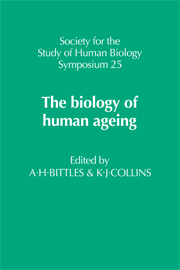Book contents
- Frontmatter
- Contents
- Preface
- Ageing as a consequence of natural selection
- Genetic information in ageing cells
- Insects as models for testing theories of ageing
- Human cell culture systems in the study of ageing
- Estimation of biological maturity in the older child
- Biological age assessment in adulthood
- Skeletal age and palaeodemography
- Cell death and the loss of structural units of organs
- The prospects for mortality decline and consequent changes in age structure of the population
- Where do old people come from? An evaluation of American population projections
- Age structure of Soviet population in the Caucasus: facts and myths
- The health of an ageing population
- Can we tell our age from our biochemistry?
- Dietary manipulation of ageing: an animal model
- Customary physical activity in the elderly
- Effects of ageing on human homeostasis
- Index
The prospects for mortality decline and consequent changes in age structure of the population
Published online by Cambridge University Press: 06 August 2010
- Frontmatter
- Contents
- Preface
- Ageing as a consequence of natural selection
- Genetic information in ageing cells
- Insects as models for testing theories of ageing
- Human cell culture systems in the study of ageing
- Estimation of biological maturity in the older child
- Biological age assessment in adulthood
- Skeletal age and palaeodemography
- Cell death and the loss of structural units of organs
- The prospects for mortality decline and consequent changes in age structure of the population
- Where do old people come from? An evaluation of American population projections
- Age structure of Soviet population in the Caucasus: facts and myths
- The health of an ageing population
- Can we tell our age from our biochemistry?
- Dietary manipulation of ageing: an animal model
- Customary physical activity in the elderly
- Effects of ageing on human homeostasis
- Index
Summary
INTRODUCTION
Over the past 150 years there have been profound changes in the sex and age structure of the United Kingdom as, first, a rise in the size of birth generations made the age structure very young as compared with a stationary population supported by constant births and experiencing constant mortality and, later, a fall in the annual numbers of births produced an ageing of the population structure. This ageing has been accentuated by steady mortality improvement, more so for women than for men. Small contributions to the ageing of the population structure were made by the virtual cessation of any substantial emigration of young men after the world economic depression of 1930 and by the war losses of young men during 1914–1918 and during 1939–1945. All countries of advanced or advancing economic development have suffered these changes and to the extent that many have in their economic development leapfrogged over the relatively slower industrial revolution of the United Kingdom, their changes in age structure have been more rapid and, in their economic implications, more violent. It is not the purpose of this presentation to make international demographic comparisons but it is important to remember that any economic problems arising from the growth in the dimensions of elderly dependency are common to all developed countries and will sooner or later confront the developing countries.
- Type
- Chapter
- Information
- The Biology of Human Ageing , pp. 133 - 154Publisher: Cambridge University PressPrint publication year: 1986
- 3
- Cited by

